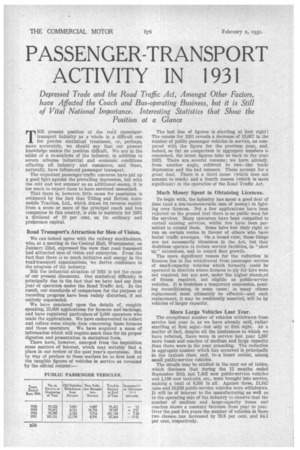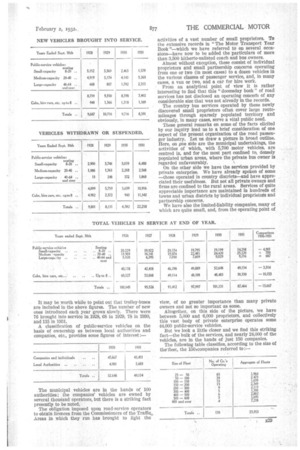PASSENGER-TRANSPORT ACTIVITY IN 1931
Page 78

Page 79

If you've noticed an error in this article please click here to report it so we can fix it.
Depressed Trade and the Road Traffic Act, Amongst Other Factors, have Affected the Coach and Bus-operating Business, but it is Still of Vital National Importance. Interesting Statistics that Show the Position at a Glance
THE present position of the road passengertransport industry as a 'whole is a difficult one for precise statistical treatment, or, perhaps, more accurately, we should say that our present knowledge makes the position difficult. We are in the midst of a re-analysis of the industry, in addition to severe adverse industrial and economic conditions affecting all industry and commerce, and these, naturally, have influenced passenger transport.
The organized passenger-traffic concerns have put up a good fight against the prevailing depression, but with the cold and wet summer as an additional enemy, it is toe much to expect them to have survived unscathed.
That there is, however, little cause for pessimism is evidenced by the fact that Tilling and British Automobile Traction, Ltd., which draws its revenue mainly from a score or more of the principal coach and bus companies in this country, is able to maintain for 1931 a dividend of 10 per cent, on its ordinary and preference capital.
Road Transport's Attraction for Men of Vision.
We can indeed agree with the railway stockholders, who, at a meeting in the Central Hall, Westminster, on January 22nd, expressed the view that road transport had attracted men of vision and enterprise. From the fact that there is so much initiative and energy in the road-transport organizations, we deriveconfidence in the progress of the industry.
But the industrial situation of 1931 is not the cause of our present discontent. Our statistical difficulty is principally due to the fact that we have had our first year of operation under the Road Traffic Act. In the result, our standards of comparison for the purpose of recording progress have been rudely disturbed, if not entirely supeiseded.
We have pondered upon the details of, roughly speaking, 25,000 applications for licences and backings, and have registered particulars of 5,000 operators who made the applications. We have endeavoured to collect and collate some simple data concerning those licences and those operators. We have acquired a mass of information which will require much time for its proper digestion and presentation in statistical form.
There have, however, emerged from the inquisition some matters of interest, which may suitably find a place in our review of the past year's operations. But by way of preface to these matters let us first look at the tangible figures of vehicles in service as revealed by the official returns:—
The last line of figures is startling at first sight ! The census for 1931 reveals a, decrease of 1307 in the number of public passenger vehicles in service, as compared with the figure for the previous year. and, indeed, so far as comparison in aggregate numbers is concerned, the latest figures take us back to the year 1923. There are several reasons; we have already, from another angle, referred to two—the trade depression and the bad summer. These account for a great deal. There is a third cause (which does not amount to much) and a fourth reason (which is more significant) in the operation of the Road Traffic Act.
Much Money Spent in Obtaining Licences.
To begin with, the industry has spent a good deal of time (and a not-inconsiderable sum of money) in fighting over licences. Not a few applications have been rejected on the ground that there is no public need for the services. Many operators have been compelled to curtail existing services, whilst few have been permitted to extend them. Some ha've lost their right to run on certain routes in favour of others who have better traffic averages. On a broad view, these things are not necessarily blemishes in the Act, but they doubtless operate to reduce service faculties, to "slow lip" extensions, and to retard fleet growth.
The more significant reason for the reduction in licences lies in the withdrawal from passenger service of small-capacity vehicles which formerly could be operated in districts where licences to ply for hire were not required, but are now, under the higher standard of fitness required, not eligible as public-service vehicles. It is doubtless a temporary suspension, pending reconditioning, in some cases; in many others replacement must ultimately be effected—and such replacement, it may be confidently asserted, will be by vehicles of larger capacity.
More Large Vehicles Last Year.
The exceptional number of vehicles withdrawn from service last year is, as we have already said, rather startling at first sight—but only at first sight. As a matter of fact, despite all the hindrances to which we hare referred, there were in service last year 1,387 more buses and coaches of medium and large capacity than there were in the year preceding. The reduction in aggregate number which has occurred is principally in tile taxicab class, and, to. -a lesser extent, among small public-service vehicles.
The details may be studied in the next set of tables, which discloses that during the 12 mouths ended September 30th last 7,402 new public-service vehicles and 1,189 new taxicabs, etc., were brought into service, making a total of 8,591 in all. Against these, 11,342 cabs and 10,916 public-service vehicles were withdrawn. It will be of interest to the manufacturing as well as to the operating side of the industry to observe that the number of medium and Iarge-capacity buses and coaches shows a constant increase from year to year. Over the past five years the number of vehicles in these two classes, has increased by 79.8 per cent. and 64.1 per cent. respectively. It may be worth while to point out that trolley-buses are included in the above figures. The number of new ones introduced each year grows slowly. There were 76 brought into service in 1928, 68 in 1929, 78 in 1930, and 115 in 1931.
A classification of public-service vehicles on the basis of ownership as between local authorities and companies, etc., provides some figures of interest :
The municipal vehicles are in the hands of 100 authorities; the companies' vehicles are owned by several thousand operators, but there is a striking fact presently to be noted.
The obligation imposed upon road-service operators to obtain licences from the Commissioners of the Traffic. Areas in which they run has brought to light the
activities of a vast number of small proprietors. To the extensive records in "The Motor Transport Year Book "-which we have referred to on several occasions-have now to be added the particulars of more than 3,500 hitherto-unlisted coach and bus owners.
Almost without exception, these consist of individual proprietors and small partnership concerns operating from one or two (in most cases) to a dozen vehicles in the various classes of passenger service, and, in many cases, a van or two, and a car for hire work.
From an analytical point of view it is rather interesting to find that this "doomsday book" of road services has not disclosed an operating conceit of any considerable size that was not already in the records.
The country bus services operated by these newly discovered small proprietors often cover large routemileages through sparsely populated territory and obviously, in many cases, serve a vital public need.
These general remarks on some of the facts elicited by our inquiry lead us to a brief consideration of one aspect of the present organization of the road passenger industry. Let us draw a picture in broad outline. Here, on pne side are the municipal undertakings, the activities of which, with 5,700 motor vehicles, are centred in, and for the most part confined to, densely populated urban areas, where the private bus owner is regarded unfavourably.
On the other side we have the services provided by private enterprise. We have already spoken of some -those operated in country districts-and have appreciated their usefulness. But not all private owners and firms are confined to the rural areas. Services of quite appreciable importance are maintained in hundreds of towns and urban districts by individual proprietm and partnership concerns. We have also the limited-liability companies, many of which are quite small, and, from the operating point of view, of no greater importance than many private owners and not so important as some.
Altogether, on this side of the picture, we have between 5,000 and 6,000 proprietors, and collectively this vast body of private enterprise operates some 44,000 public-service vehicles. But we look a little closer and we find this striking fact-the bulk of the services, and nearly 24,000 of the vehicles, are in the hands of just 150 companies.
The following table classifies, according to the size of the'fleet, the 150,companies referred to:




































































































































































